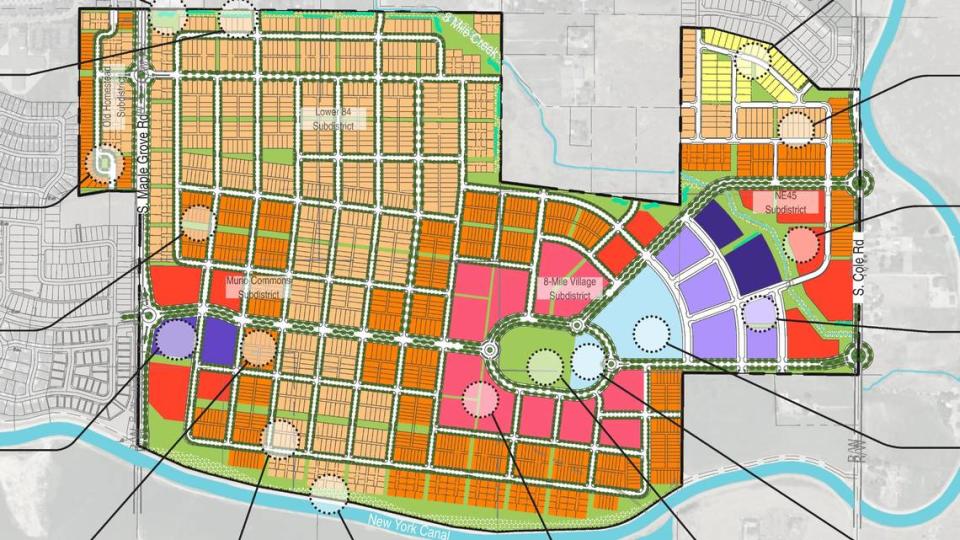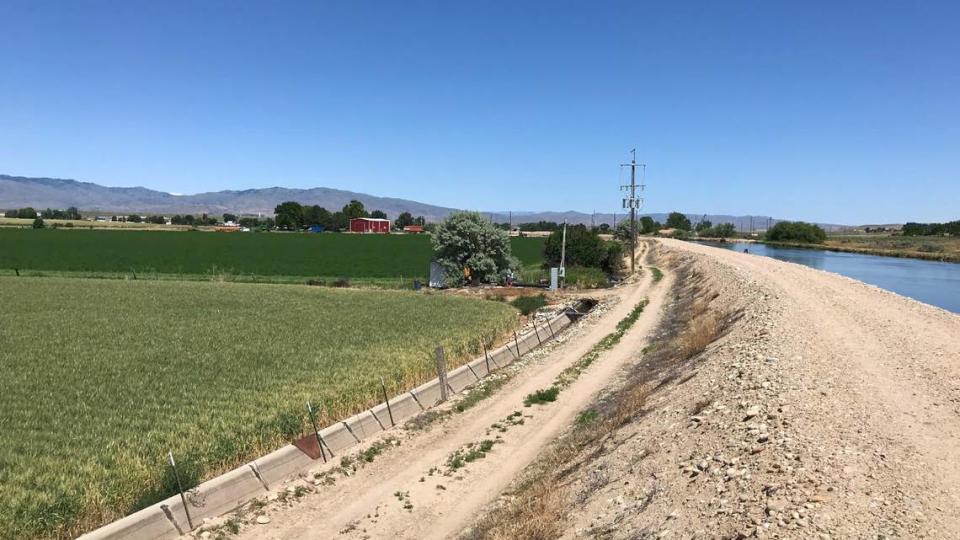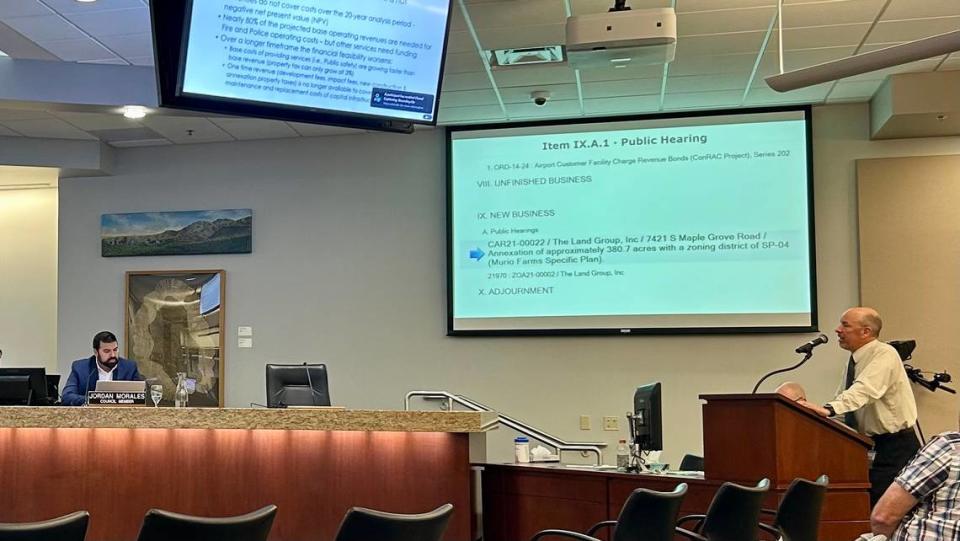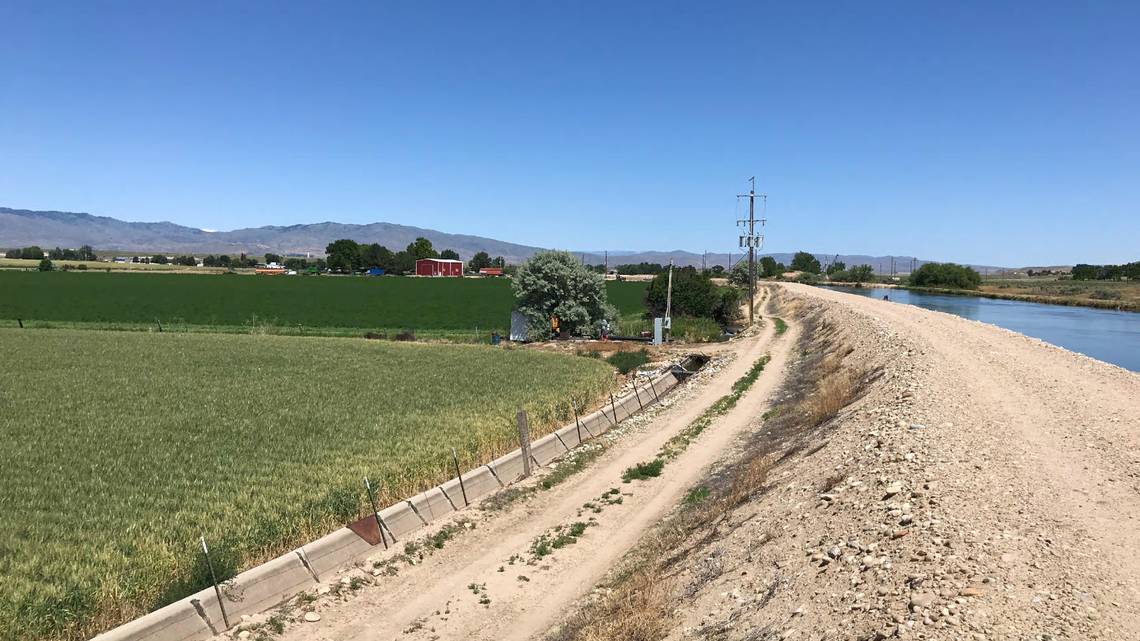Plans to annex nearly 381 acre in Southwest Boise to build more than 3,500 homes nearly collapsed at the Boise City Council after the Planning and Zoning Commission and city staff recommended denial over financial concerns.
But council members chose to push back against those recommendations after hours of debate, asking the staff and the developer to rework their numbers and see if there was a chance to make the large planned community a reality.
The development from the influential Murgoitio family, dubbed Murio Farms, would have over 1,800 single-family homes and over 1,700 apartments built over 20 years, according to a summary from Boise’s Planning and Development Services Department.
It would have five residential zones, three mixed-use zones and a seven-acre site for a future elementary school. The plans call for nearly 95,000 square feet of commercial space.
The Murgoitios sought to convert their farmland into a community that offered housing, community spaces and neighborhood businesses, according to Deborah Nelson, a partner with Boise’s Givens Pursley law firm representing The Land Group and the Murgoitios. The Land Group is an Eagle engineering and architecture firm working with the Murgoitios on Murio Farms.
“Their dairy farm is no longer viable, but the land can serve another valuable purpose for the city by providing much-needed housing near employment centers,” Nelson said during a Boise Planning and Zoning Commission meeting in March.
The family, which is Basque-American, hoped to create a planned community that reflected that ancestry and planned for the centerpiece of Murio Farms to be a community park called the Village Greens and a civic space called the Txoko Community Center.
The community center would be adjacent to the school and would be modeled after a traditional Basque gathering site with a focus on shared meals and socializing, according to Nelson.
Designs also called for “abstracted Basque flags and benches and tree grating, lighting fixtures and old-world, European-style pavers,” Nelson said.

Boise’s need for housing
A recurring theme at the City Council meeting Tuesday and the Planning and Zoning Commission in March was the need for more Boise housing.
The metro Boise population is about 813,000, Nelson said, and is projected to exceed 1 million within the next decade.
To meet the demand, the city needed to add over 2,700 new homes every year and over 27,000 new homes by 2030, according to a 2021 study commissioned by the city. Boise missed that mark by over 4,000 homes between 2018 and 2020.
In March, Nelson said the city’s Southwest Boise Planning area — which is bordered by Interstate 84 to the north and the New York Canal to the south — has 762 acres of land available for new homes. The Murio Farms site contains over half of that with 381 acres, about the size of 287 football fields.
“The Southwest Planning Area has one concentrated area left to meet this critical need: the Murio Farms site … one of the last and largest undeveloped areas not only in the southwest, but in the city,” Nelson said then.
The site is also near the Boise Airport’s growing industrial complex, Amazon and WinCo distribution centers, and Micron, which is planning a $15 billion expansion the company says will create 2,000 direct jobs and 15,000 indirect jobs.
“If Boise employees cannot find housing in Boise, they will go elsewhere, promoting regional sprawl, extending commute times, and generating even more traffic and emissions,” Nelson said.


A perfect community plan, almost
The plan checks nearly all of the boxes that the city is looking for in new developments since the new zoning code went live in December. It’s dense. It adds more homes and mixes them with businesses. It fits the plan the city intended for the area.
“Conceptually, this is exactly what we want in our community,” said Mayor Lauren McLean.
City staff also generally approved of the plan and believed it fit the city’s goals. But it had a major flaw: The city tax revenues generated by the community would not cover one-time and ongoing costs to build and maintain services to it such as with sewer, police and fire, according to Mike Sherack, senior budget analyst for the city.
“We don’t see that it’s a financially feasible decision for to make this annexation,” Sherack said.
Sherack said nearly 80% of the projected base operating revenues are needed for fire and police operating costs. Total revenue collected from Murio Farms by 2040 would be nearly $6 million, while total expenses would be nearly $7.1 million, according to the annexation cost analysis.
As time drags on, Sherack said the financial feasibility of the development would worsen.
“Each year we’re about $1.1 million going forward in the red, and over time we do not see that improving,” Sherack said.


Nelson said the city’s financial analysis was flawed for three reasons: It assumed that all single-family homes would be owner-occupied and qualify for the $125,000 homeowner’s exemption, it assumed Boise would need more police officers than required, and it under-valued properties.
If Boise conservatively corrected the errors, Nelson said, the fiscal impact would flip to the positive, as an earlier city analysis had found.
Council members also had a difficult time with the staff’s financial analysis, repeatedly asking questions about what had changed since an earlier analysis in 2021.
According to Sherack, city staff redid the analysis because several factors had changed, including the Boise Police Department seeking to increase the number of police officers per resident and inflation.
Also, since the first analysis, Idaho has enacted a law limiting the amount of spending cities can add to their budgets from new construction projects and annexation to 90% of the amount the properties’ taxes would otherwise generate, according to prior Idaho Statesman reporting.
Sherack said that drop was “significant” for Murio Farms.
City staff also referred to an ACHD study that found the area had inadequate traffic capacity and street infrastructure to support the community.
“The street network within the surrounding area would need to be significantly expanded beyond the 2020 (capital improvement plan) to continue to provide the acceptable ACHD level of service at project buildout,” according to a staff summary.
The council asked city staff to look at the financial numbers again and work with the Murgoitio and ACHD before presenting their findings at a work session.
Boise: Building community or adding sprawl?
Murio Farms would join a host of other planned communities already planned for the area, including the 2,000-home, 600-acre Locale; the 2,775-home, 762-acre Spring Rock; and the 1,000-home Valor in Kuna.
Some residents have described the area as a “sea of houses,” with little in the way of amenities or businesses.
In January, a meeting of the Board of Ada County Commissioners stretched for nearly three hours as residents spoke out against a developer’s goal to rezone a 10-acre piece of land in Southwest Boise from purely commercial to a mix of residential and business uses. Utah investment firm Peg Cos. proposed the development, called Alante Homes at Hazelwood Village, at 6381 S. Five Mile Road, roughly 1½ miles from Murio Farms.
The nearby residents’ biggest complaint? It can take over 30 minutes to drive to any nearby shopping center, and they have limited options for dining, entertainment and retail, according to prior Idaho Statesman reporting.
“There is nowhere to go to take (my kids) out to eat,” said Nick Nettles, a Southwest Boise resident, at the time. “We are prisoners in our home unless we want to sit in traffic for 25-30 minutes.”
The same issues cropped up in the discussion over Murio Farms, with nearby residents and presidents of the South Cole and Southwest Ada County neighborhood associations speaking against the planned community.
They focused on the lack of commercial and emergency services, cost and transportation issues.
“We are getting so many additional homes in the area that the infrastructure can’t keep up,” said Estee Lafrenz, president of the South Cole Neighborhood Association.
Lafrenz, and several Southwest Boise residents, said that to buy groceries or go to work, most people have to drive north along just a few roads that are already congested with traffic.
“I really am concerned about the affects of this much traffic on the roads as they are now,” said Marisa Keith, the president of the Southwest Ada County Alliance neighborhood association.
Nelson said if the city council doesn’t approve the project, the Murgoitios would seek other ways to build on the land, which could mean going through Ada County instead.
Many of the neighbors acknowledged that the area would be developed one way or another but hoped that plans would better address surrounding infrastructure, transportation, water and overcrowded schools.
Nelson said she didn’t know what that would look like, but it could mean less density.
A bevy of Murgoitio family members attended the meeting and made it clear that, after over 100 years farming the land, they wanted to partner with the city on the project and did not want to have to go through the county process.
“We want what is best for the use of our land,” said Lou Murgoitio. “Our vision aligns with the city’s vision, to use this precious resource to provide needed housing.”
The Murgoitios spoke about a shared history with Boise and how they aimed to work with the city from the start of the development process.
“This is our home too, not just our legacy,” Lou Murgoitio said.
Dream to bring 1,500 homes to South & Southwest Boise still on the table. Here’s the plan
What happens when you build houses, but no stores? This Boise neighborhood is finding out
‘We’re overwhelmed’: New proposal, annexation could add thousands of homes to SW Boise
After decades of inaction, Boise might now annex area with 34,000 people. What happened?
